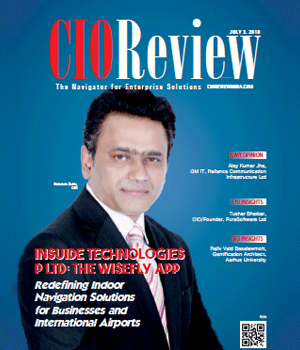
Evolution of RPA: From Rule - Based to Intelligent Cognitive Automation
CIO Review Team | Friday, 27 July 2018, 13:35 IST
 11 June 2018 – The Automation Technology Market is Anticipated to bring the Second largest Economic Revolution after Mobile Internate and Smart phone . Automation Technology the Impact the Economy by $6.7 Trillion by 2025 that Business. IT ecosystem while the small and medium scale enterprises (SMEs) started pilot projects to test RPA capabilities. Processes that were rule based, reputable, of high volume, relying on multiple systems and had high risk factors were suitable candidates for RPA transitions.
11 June 2018 – The Automation Technology Market is Anticipated to bring the Second largest Economic Revolution after Mobile Internate and Smart phone . Automation Technology the Impact the Economy by $6.7 Trillion by 2025 that Business. IT ecosystem while the small and medium scale enterprises (SMEs) started pilot projects to test RPA capabilities. Processes that were rule based, reputable, of high volume, relying on multiple systems and had high risk factors were suitable candidates for RPA transitions.
Cases for RPA, inspiring buyers to invest. Buoyed by enthusiasm for RPA, the industry has also witnessed a mushrooming of automation tools and platform vendors that provide different automation capabilities, therefore pushing the adoption rate further. Combined with all the media attention and growing expertise and skills, the automation industry is moving at a rapid pace, and is only going to get bigger and better, moving from just a tactical technology to becoming an overall digitization strategy.
What RPA can do
An RPA system currently can imitate the rule-based jobs that humans interface with at the "presentation layer." A single process could be automated within two to three weeks, delivering value thereafter. The "robot" can then continue processing that activity 24/7/365 days a year if required, with every action being completely traceable.
For example, if a law firm is managing a property portfolio on behalf of a client, they would be expected to carry out land registry checks at some point. This is commonly a paralegal role that might involve the person getting a request from a lawyer, or from the client directly, probably via a template, an email or a workflow system.
Now, this whole process can be done by RPA without any human intervention. RPA in the above example demonstrates some of major benefits:
- The cost of the robot is a fraction of that of the human.
- The robot will work 24/7 every day every year unlike humans.
- No need for IT or process changes as the robot will carry out tasks as the human does.
- The robot once trained will process the same way without deviation at all times.
- Unlike humans, robots do not have a time constraints.
One of the biggest constraints of RPA is that it needs structured data in the form of a spreadsheet, a web form or a database for the robots to work flawlessly. Cognitive intelligence combined with machine learning builds this ability in RPA where it can deal with the unstructured, or semi-structured data and transform it into a structured form, which can then be processed by the robots.
RPA robots can also be triggered in case there was a change in regulation and all contracts of a specific type that need updating.
RPA fails when it comes to decision making in a process. For instance, in the process of loan application, the initial stage of information submission into the CRM system can be automated through RPA. After the submission of the data, decision making for the approval or non-approval of the loan needs to be done.
If the decision is relatively simple, it can still be handled by RPA. However, complex decisions need the intelligence of cognitive techniques. Hence the combination of RPA and cognitive intelligence will allow users to do end to end automation for many processes, and achieve greater efficiency benefits as compared to the partially automated ones.
CIO Viewpoint
Upcoming Technological Advancements in Payments...
By Pinak Chakraborty, CIO of Airtel Payments Bank
Shaping the Future of AI: Talent, Innovation,...
By Yann LeCun, Chief AI Scientist at Meta
Future of Smart Manufacturing: Integrating Tech...
By Mohammed Kaishulla, Chief information officer, EPACK Durable
CXO Insights
When the Internet of Things meets Analytics
By Salil Godika, Chief Strategy & Marketing Officer, Happiest Minds Technologies
Cyber Risks: Balancing Innovation and Resilience
By Aditya Samag, VP-Cyber Risk, Marsh India Insurance Brokers
Perfect Plant Initiative Embraced with Industry...







